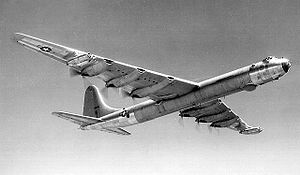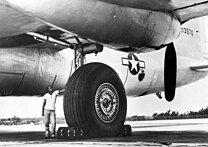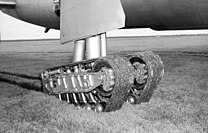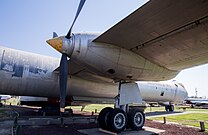|
Convair B-36 Peacemaker
The Convair B-36 "Peacemaker"[N 1] is a strategic bomber built by Convair and operated by the United States Air Force (USAF) from 1949 to 1959. The B-36 is the largest mass-produced piston-engined aircraft ever built, although it was exceeded in span and weight by the one-off Hughes H-4 Hercules. It has the longest wingspan of any combat aircraft. The B-36 was capable of intercontinental flight without refueling. Entering service in 1948, the B-36 was the primary nuclear weapons delivery vehicle of Strategic Air Command (SAC) until it was replaced by the jet-powered Boeing B-52 Stratofortress beginning in 1955. All but four aircraft have been scrapped. Development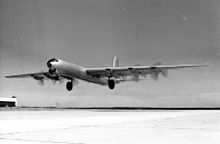 The design of the B-36 can be traced to early 1941, prior to the entry of the United States into World War II. At the time, Britain was at risk of falling to the Nazi "Blitz" attacks, making strategic bombing attacks by the United States Army Air Corps (USAAC) against Germany impossible with the aircraft available.[2] The United States would need a new bomber to reach Europe and return to bases in North America,[3] necessitating a combat range of at least 5,700 mi (9,200 km), the length of a Gander, Newfoundland–Berlin round trip. The USAAC therefore sought a bomber of truly intercontinental range.[4][5] The German Reichsluftfahrtministerium's (RLM) would request the similar ultralong-range Amerikabomber program on 12 May 1942. The USAAC sent out an initial request on 11 April 1941, asking for a 450 mph (720 km/h) top speed, a 275 mph (443 km/h) cruising speed, a service ceiling of 45,000 ft (14,000 m) and a maximum range of 12,000 mi (19,000 km) at 25,000 ft (7,600 m).[6] These requirements were too demanding and far exceeded the technology of the day,[4] so on 19 August 1941, they were reduced, to a maximum range of 10,000 mi (16,000 km), an effective combat radius of 4,000 mi (6,400 km) with a 10,000 lb (4,500 kg) bomb-load, a cruising speed between 240 and 300 mph (390 and 480 km/h), and a service ceiling of 40,000 ft (12,000 m)[3] The ceiling in both cases was chosen to exceed the maximum effective altitude of most of Nazi Germany's anti-aircraft guns. World War II and after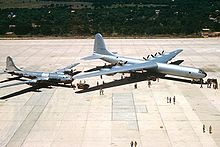 In the Pacific, the USAAF needed a bomber capable of reaching Japan from bases in Hawaii, and the development of the B-36 became a priority. Secretary of War Henry L. Stimson, in discussions with high-ranking officers of the USAAF, decided to waive normal army procurement procedures. On 23 July 1943, 15 months after the Germans' Amerikabomber proposals, and the same day that the German firm Heinkel began design on a six-engined bomber of their own,[7] the USAAF submitted a "letter of intent" to Convair for an initial production run of 100, even before testing of the two prototypes was complete.[8]: 3−10 The first delivery was due in August 1945, and the last in October 1946, but Consolidated (by now renamed Convair after merging with Vultee Aircraft) delayed delivery. Three months after V-E Day the aircraft was unveiled on 20 August 1945, and flew for the first time on 8 August 1946.[9] After the start of the Cold War with the 1948 Berlin Airlift, and the 1949 atmospheric test of the first Soviet atomic bomb, American military planners sought bombers capable of delivering the very large and heavy first-generation atomic bombs. The B-36 was the only American aircraft with the range and payload to carry such bombs from airfields on American soil to targets in the USSR. The modification to allow the use of larger atomic weapons on the B-36 was called the "Grand Slam Installation".[8]: 24 The B-36 was obsolete from the outset, while it now faced the widespread introduction of opposing jet fighters.[2][10] The Boeing B-47 Stratojet, its jet engined counterpart, did not become fully operational until 1953, and lacked the range to attack the Soviet Union from North America without aerial refueling and could not carry the huge Mark 16 hydrogen bomb. The other American piston bombers of the day, the Boeing B-29 Superfortress and Boeing B-50 Superfortress, were also too limited in range.[11]: 124–126 Intercontinental ballistic missiles did not become sufficiently reliable until the early 1960s. Until the Boeing B-52 Stratofortress became operational in 1955, the B-36 was the primary nuclear weapons delivery vehicle of the SAC.[2] Convair touted the B-36 as the "aluminum overcast", a so-called "long rifle", giving SAC truly global reach.[2] During General Curtis LeMay's tenure as head of SAC (1949–57), the B-36 formed the heart of the Strategic Air Command. Its maximum payload was more than four times that of the B-29 and exceeded that of the later B-52. The B-36 was slow and could not refuel in midair, but could fly missions to targets 3,400 mi (5,500 km) away and stay aloft as long as 40 hours.[2] Moreover, the B-36 was believed to have "an ace up its sleeve": a phenomenal cruising altitude for a piston-driven aircraft, made possible by its huge wing area and six engines, putting it out of range of most interceptors, as well as ground-based anti-aircraft guns.[2] Experimentals and prototypesConsolidated Vultee Aircraft Corporation (later Convair) and Boeing Aircraft Company took part in the competition, with Consolidated winning a tender on 16 October 1941. Consolidated asked for a $15 million contract with $800,000 for research and development, mockup, and tooling. Two experimental bombers were proposed, the first to be delivered in 30 months, and the second within 36 months. Originally designated Model B-35, the name was changed to B-36 to avoid confusion with the Northrop YB-35 piston-engined flying-wing bomber,[4][12]: 26–28 against which the B-36 was meant to compete for a production contract. Throughout its development, the B-36 program encountered delays. When the United States entered World War II, Consolidated was ordered to slow B-36 development to greatly increase Consolidated B-24 Liberator production. The first mockup was inspected on 20 July 1942, following six months of refinements. A month after the inspection, the project was moved from San Diego, California, to Fort Worth, Texas, which set back development several months. Consolidated changed the tail from a twin-tail to a single, thereby saving 3,850 lb (1,750 kg), but this change delayed delivery by a further 120 days. Changes in the USAAF requirements added back the weight saved in redesigns, and cost more time. A new antenna system needed to be designed to accommodate a new radio and radar system and the Pratt and Whitney engines were redesigned, adding another 1,000 lb (450 kg).[12]: 30 Design The B-36 was two-thirds longer than the previous "superbomber", the B-29 and its wingspan and height exceeded those of the Soviet Union's 1960s Antonov An-22, the largest turboprop aircraft ever produced.[2] Only with the advent of the Boeing 747 and the Lockheed C-5 Galaxy, both designed two decades later, did aircraft capable of lifting a heavier payload enter service. The wings of the B-36 were large even when compared with present-day aircraft, exceeding, for example, those of the C-5 Galaxy, and enabled the B-36 to carry enough fuel to fly the intended long missions without refueling. The maximum thickness of the wing, measured perpendicular to the chord, was 7.5 ft (2.3 m), containing a crawlspace that allowed access to the engines.[13] The wing area permitted cruising altitudes well above the operating ceiling of any 1940s-era fighters, at over 40,000 ft (12,000 m).[14] In 1954, the turrets and other nonessential equipment were stripped out (not unlike the earlier Silverplate program for the atomic bomb-carrying "specialist" B-29s), resulting in a "featherweight" configuration that increased top speed to 423 mph (681 km/h),[15] and cruise at 50,000 ft (15,000 m) and dash at over 55,000 ft (17,000 m), perhaps even higher.[11]: 136–137 The large wing area, with the four jet engines supplementing the piston engines in later versions gave the B-36 a wide margin between stall speed (VS) and maximum speed (Vmax) at these altitudes. This made the B-36 more maneuverable at high altitude than most jet interceptors of the day, which could not maneuver effectively above 40,000 ft (12,000 m).[16] However, the U.S. Navy McDonnell F2H Banshee fighter could intercept the B-36, thanks to its ability to operate at more than 50,000 ft (15,000 m).[17] Later, the new Secretary of Defense, Louis A. Johnson, who considered the U.S. Navy and naval aviation essentially obsolete in favor of the USAF and SAC, forbade putting the Navy's claim to the test.[18] The propulsion system of the B-36 was unique, with six 28-cylinder Pratt & Whitney R-4360 Wasp Major radial engines mounted in an unusual pusher configuration, rather than the conventional tractor propeller layout of other heavy bombers. The prototype's six R-4360s delivered 18,000 hp (13,000 kW) which resulted in early B-36s needing long takeoff runs, which was ameliorated when power was boosted to 22,800 hp (17,000 kW).[11]: 137–138 Each engine drove a three-bladed propeller, 19 ft (5.8 m) in diameter, mounted in a pusher configuration. This unusual configuration prevented propeller turbulence from interfering with airflow over the wing, but led to engine overheating due to insufficient airflow around the engines, resulting in inflight engine fires. The large, slow-turning propellers interacted with the high-pressure airflow behind the wings to produce an easily recognizable very-low-frequency pulse at ground level that betrayed approaching flights. Addition of jet propulsionBeginning with the B-36D, Convair added a pair of General Electric J47-19 jet engines suspended near the end of each wing which were also retrofitted to surviving B-36Bs. Consequently, the B-36 was configured to have 10 engines, six radial propeller engines and four jet engines, leading to the B-36 slogan of "six turnin' and four burnin'". The B-36 had more engines than any other mass-produced aircraft. The jet pods greatly improved takeoff performance and dash speed over the target. In normal cruising flight, the jet engines were shut down to conserve fuel. When the jet engines were shut down, louvers closed off the front of the pods to reduce drag.[19] The two pods with four turbojets and the six piston engines combined gave the B-36 a total of 40,000 hp (30,000 kW) for short periods of time.[20] CrewThe B-36 had a crew of 15. As with the B-29 and B-50, the pressurized flight deck and crew compartment were linked to the rear compartment by a pressurized tunnel through the bomb bay. In the B-36, movement through the tunnel was on a wheeled trolley, pulling on a rope. The rear compartment featured six bunks and a dining galley and led to the tail turret.[21] Landing gearThe main landing gear evolved from a single-wheel design (top) to a 4-wheel bogie (bottom), but a tracked assembly (center) was also tested. The tricycle landing gear of the XB-36 featured a single-wheel main landing gear whose tires were the largest ever manufactured up to that time: 9 ft 2 in (2.79 m) tall, 3 ft (0.91 m) wide, and weighing 1,320 lb (600 kg), with enough rubber for 60 automobile tires.[2][irrelevant citation] These tires placed so much ground pressure on runways that the XB-36 was restricted to Carswell Field adjacent to the factory in Texas, Eglin Field in Florida, and Fairfield-Suisun Field in California.[22]: 14–15 The single-wheel gear was soon replaced by a four-wheeled bogie.[23][4][24][12]: 29 At one point, a tank-like tracked landing gear was also tried on the XB-36,[25] but it proved heavy and noisy and was soon abandoned. Weaponry
The four bomb bays could carry up to 87,200 lb (39,600 kg) of bombs, more than 10 times the load carried by the World War II Boeing B-17 Flying Fortress.[26] The B-36 was not designed with nuclear weapons in mind, because the existence of such weapons was top secret during the period when the B-36 was conceived and designed, and the initial B-36A was not capable of accommodating them.[27] Nevertheless, the B-36 stepped into its nuclear delivery role immediately upon becoming operational. In all respects except speed, the B-36 could match what was arguably its approximate Soviet counterpart, the later Tu-95.[28] Until the B-52 became operational, the B-36 was the only means of delivering the first generation Mark 17 hydrogen bomb,[29] 25 ft (7.6 m) long, 5 ft (1.5 m) in diameter, and weighing 42,000 lb (19,000 kg), the heaviest and bulkiest American aerial nuclear bomb. The Mark 17 took up the aircraft's two aft bomb bays, while the forward bay could hold a Mark 6 atomic weapon.[30] The defensive armament consisted of six retractable gun turrets, with side-by-side turrets mounted in forward dorsal, aft dorsal and ventral positions, aft dorsal and non-retractable tail and nose turrets. Each turret was fitted with two 20 mm (0.79 in) cannon, for a total of 16, and all turrets were remote controlled.[31] Recoil vibration from gunnery practice often caused the aircraft's electrical wiring to jar loose or the vacuum tube electronics to malfunction, leading to failure of the aircraft controls and navigation equipment, which contributed to the crash of B-36B 44-92035 on 22 November 1950.[32] 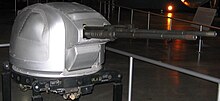 The Convair B-36 was the only aircraft capable of carrying the T-12 Cloudmaker, a gravity bomb weighing 43,600 lb (19,800 kg) and designed to produce an earthquake bomb effect. Part of the testing process involved dropping two of them in a single flight, one from 30,000 ft (9,100 m) and the second from 40,000 ft (12,000 m). The first prototype XB-36 flew on 8 August 1946. The speed and range of the prototype failed to meet the standards set out by the USAAC in 1941. This was expected, as the Pratt & Whitney R-4360 engines required were not yet available.[8]: 12−13 [12]: 32 A second aircraft, the YB-36, flew on 4 December 1947. It had a redesigned, high-visibility, yet still heavily framed greenhouse dome-shaped canopy, which was later adopted for production, and the engines used on the YB-36 were more powerful and more efficient. Altogether, the YB-36 was much closer to the production aircraft.  The first 21 B-36As were delivered in 1948 as interim airframes intended for crew training. No defensive armament was fitted, since none was ready. All surviving B-36As were converted to RB-36E reconnaissance models once later models became available. Deliveries began in November 1948 of the combat-capable B-36B, which finally met the 1941 requirements, but had serious engine reliability and maintenance problems (changing the 336 spark plugs was a task dreaded by ground crews) and with the availability of weapons and spares. Later models had more powerful R-4360 engines, improved radar, and redesigned crew compartments. The jet engines increased fuel consumption and reduced range. Gun turrets were already recognized as obsolete, and newer bombers had only a tail turret, or no gunners at all for several years but the development of air-to-air missiles, such as the Soviet K-5 which began test firings in 1951, eliminated remaining justifications for keeping them. In February 1954, the USAF awarded Convair a contract for a new "Featherweight" program, which significantly reduced weight and crew size. The three configurations were:
The six turrets eliminated by Featherweight I reduced the crew from 15 to 9. Featherweight III had a longer range and an operating ceiling of at least 47,000 ft (14,000 m), especially valuable for reconnaissance missions. The B-36J-III configuration (the last 14 made) had a single radar-aimed tail turret, extra fuel tanks in the outer wings, and landing gear allowing the maximum gross weight to be increased to 410,000 lb (190,000 kg). Production of the B-36 ceased in 1954.[33] Operating and financial problemsDue to problems that occurred with the B-36 in its early stages of testing, development, and later in service, some critics referred to the aircraft as a "billion-dollar blunder".[34] In particular, the United States Navy saw it as a costly bungle, diverting congressional funding and interest from naval aviation and aircraft carriers in general, and carrier–based nuclear bombers in particular. In 1947, the Navy attacked congressional funding for the B-36, alleging it failed to meet Pentagon requirements. The Navy held to the pre-eminence of the aircraft carrier in the Pacific during World War II, presuming carrier-based aircraft would be decisive in future wars. To this end, the Navy designed USS United States, a "supercarrier" capable of launching huge fleets of tactical aircraft or nuclear bombers. It then pushed to have funding transferred from the B-36 to USS United States. The Air Force successfully defended the B-36 project, and United States was cancelled by Secretary of Defense Louis A. Johnson in a cost-cutting move over the objections of both Secretary of the Navy John L. Sullivan and the Navy's senior leadership. Sullivan resigned in protest and was replaced as Secretary of the Navy by Francis P. Matthews, who had limited familiarity with defense issues, but was a close friend of Johnson. Several high-level Navy officials questioned the government's decision in cancelling the United States to fund the B-36, alleging a conflict of interest because Johnson had once served on Convair's board of directors. The uproar following the cancellation of United States in 1949 was nicknamed the "Revolt of the Admirals", during which time Matthews dismissed and forced into retirement the serving Chief of Naval Operations (CNO), Admiral Louis E. Denfeld, following Denfeld's testimony before the House Armed Services Committee.[35]: 42 The congressional and media furor over the firing of Admiral Denfeld, as well as the significant use of aircraft carriers in the Korean War, resulted in the Truman administration subsequently ousting both Johnson and Matthews, and procuring Forrestal-class supercarriers, which were similar in size to United States, but geared towards multirole use with air wings of fighter, attack, reconnaissance, electronic warfare, early warning and antisubmarine-warfare aircraft. Simultaneously, heavy manned bombers for SAC were also deemed crucial to national defense and the two systems would never again be in competition for funding.[36][35] Operational history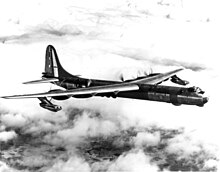 The B-36, including its GRB-36, RB-36, and XC-99 variants, was in USAF service as part of the SAC from 1948 to 1959. The RB-36 variants of the B-36 were used for reconnaissance during the Cold War with the Soviet Union and the B-36 bomber variants conducted training and test operations and stood ground and airborne alert, but were never flown offensively as bombers against hostile forces.[37] Maintenance The Wasp Major engines had a prodigious appetite for lubricating oil and each engine required a dedicated 100 US gal (380 L) tank.[citation needed] Normal maintenance consisted of tedious measures, such as changing the 56 spark plugs on each of the six engines which were often fouled by the lead in the 145 octane antiknock fuel required. Thus, each service required changing 336 spark plugs. The B-36 was too large to fit in most hangars. Since even an aircraft with the range of the B-36 needed to be stationed as close to enemy targets as possible, this meant the plane was largely based in the extreme weather locations of the northern continental United States, Alaska, and the Arctic. Since the maintenance had to be performed outdoors, the crews were largely exposed to the elements, with temperatures of −60 °F (−51 °C) in winters and 100 °F (38 °C) in summers, depending on the location. Special shelters were built to provide the maintenance crews a modicum of protection. Ground crews were at risk of slipping and falling from icy wings. The wing roots were thick enough, at 7 ft (2.1 m), to enable a flight engineer to access the backs of the engines and the landing gear during flight by crawling through the wings but was only possible at lower altitudes.[38] In 1950, Consolidated-Vultee developed streamlined pods that looked like large drop tanks that mounted on each side of the fuselage to carry spare engines between bases. Each pod could airlift two engines. When the pods were empty, they were removed and carried in the bomb bays. No record exists of the pods being used.[39] Engine fires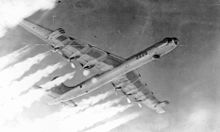 As engine fires occurred with the B-36's radial engines, some crews humorously changed the aircraft's slogan from "six turning, four burning" into "two turning, two burning, two smoking, two choking and two more unaccounted for".[40][N 2] This problem was exacerbated by the propellers' pusher configuration, which increased carburetor icing. The design of the R-4360 engine tacitly assumed that it would be mounted in the conventional tractor configuration with the air flowing in the order of propeller/air intake/cylinders and to the carburetor. In this configuration, the carburetor is bathed in warm air flowing past the engine, so is unlikely to ice up. However, they were mounted backwards in the B-36 and the carburetor was in front of the engine, where it would not benefit from engine heat and made more existing carburetor heat systems unsuitable.[why?] Hence, when intake air was cold and humid, ice gradually obstructed the carburetor intake, which increased the air/fuel mixture richness until unburned fuel in the exhaust caught fire.[41] Three engine fires of this nature led to the first loss of an American nuclear weapon when a B-36 crashed in February 1950. Crew experience Training missions were typically in two parts, a 40-hour flight—followed by time on the ground for refueling and maintenance—and then a 24-hour second flight. With a sufficiently light load, the B-36 could fly at least 10,000 mi (16,000 km) nonstop, and the highest cruising speed of any version, the B-36J-III, was at 230 mph (370 km/h). Engaging the jet engines could raise the cruising speed to over 400 mph (640 km/h). Hence, a 40-hour mission, with the jets used only for takeoff and climbing, flew about 9,200 mi (14,800 km). Due to its size, the B-36 was never sprightly or agile. Lieutenant General James Edmundson likened it to "sitting on your front porch and flying your house around".[42] Crew compartments were nonetheless cramped, especially when occupied for 24 hours by a crew of 15. War missions would have been one-way, taking off from forward bases in Alaska or Greenland, overflying the USSR, and landing in Europe, Morocco, or the Middle East. Veteran crews recall feeling confident in their ability to fly the missions, but not to survive weapon delivery, as the aircraft were not fast enough to escape the blast.[43] These concerns were confirmed by the 1954 Operation Castle tests, in which B-36s were flown at combat distances from detonations of bombs in the 15-megaton range. At distances typical of wartime delivery, aircraft suffered extensive flash and blast damage.[44][failed verification] Experiments The B-36 was employed in a variety of aeronautical experiments throughout its service life. Its immense size, range, and payload capacity lent itself to use in research and development programs. These included nuclear propulsion studies, and "parasite" programs in which the B-36 carried smaller interceptors or reconnaissance aircraft.[45] In May 1946, the Air Force began the Nuclear Energy for the Propulsion of Aircraft project, which was followed in May 1951 by the Aircraft Nuclear Propulsion (ANP) program. The ANP program used modified B-36s to study shielding requirements for an airborne reactor to determine whether a nuclear-powered aircraft was feasible.[46] Convair modified two B-36s under the MX-1589 project. The Nuclear Test Aircraft was a B-36H-20-CF (serial number 51-5712) that had been damaged in a tornado at Carswell AFB on 1 September 1952. This aircraft, redesignated the XB-36H (and later NB-36H), was modified to carry a 1 MW, air-cooled nuclear reactor in the aft bomb bay, with a four-ton lead disc shield installed in the middle of the aircraft between the reactor and the cockpit. A number of large air intake and exhaust holes were installed in the sides and bottom of the aircraft's rear fuselage to cool the reactor in flight. On the ground, a crane would be used to remove the 35,000 lb (16,000 kg) reactor from the aircraft. To protect the crew, the highly modified cockpit was encased in lead and rubber, with a 1 ft-thick (30 cm) leaded glass windshield. The reactor was operational, but did not power the aircraft as its purpose was to investigate the effect of radiation. Between 1955 and 1957, the NB-36H completed 47 test flights and 215 hours of flight time, during 89 of which the reactor was critical.[citation needed] Other experiments involved providing the B-36 with its own fighter defense in the form of parasite aircraft carried partially or wholly in a bomb bay. One parasite aircraft was the diminutive football-shaped McDonnell XF-85 Goblin, which docked using a trapeze. The concept was tested using a B-29 carrier, but docking was difficult even for experienced test pilots. Moreover, the XF-85 was no match for contemporary foreign powers' interceptors in development or in service and consequently the project was cancelled.[citation needed] The FICON project was more successful and involving a modified B-36 (a GRB-36D "mothership") and the RF-84K, a fighter modified for reconnaissance, in a bomb bay. The GRB-36D would ferry the RF-84K to the vicinity of the objective, whereupon the RF-84K would disconnect and begin its mission. Ten GRB-36Ds and 25 RF-84Ks were built and had limited service in 1955–1956.[citation needed] Projects Tip Tow and Tom-Tom involved docking F-84s to the wingtips of B-29s and B-36s. The hope was that the increased aspect ratio of the combined aircraft would result in a greater range. Project Tip Tow was cancelled when an EF-84D and a specially modified test EB-29A crashed, killing everyone on both aircraft. This accident was attributed to the EF-84D flipping over onto the wing of the EB-29A. Project Tom-Tom, involving RF-84Fs and a GRB-36D from the FICON project (redesignated JRB-36F), continued for a few months after this crash, but was also cancelled due to the violent turbulence induced by the wingtip vortices of the B-36.[47] Strategic reconnaissance One of the SAC's initial missions was to plan strategic aerial reconnaissance on a global scale. The first efforts were in photo-reconnaissance and mapping. Along with the photo-reconnaissance mission, a small electronic intelligence cadre operated. Weather reconnaissance was part of the effort, as was long-range detection of Soviet atomic explosions. In the late 1940s, strategic intelligence on Soviet capabilities and intentions was scarce. Before the development of the Lockheed U-2 high-altitude spy plane and Corona orbital reconnaissance satellites, technology and politics limited American reconnaissance efforts to the borders, of the Soviet Union.[49] One of the essential criteria of the early postwar reconnaissance aircraft was the ability to cruise above 40,000 ft (12,000 m), a level partly determined by knowledge of the capability of Soviet air-defense radar. The main Soviet air-defense radar in the 1950s was the American-supplied SCR-270, or locally made copies, which were only effective up to 40,000 ft (12,000 m) – in theory, and an aircraft cruising above this level likely would remain undetected.[16][page needed] The first aircraft to put this theory to the test was the RB-36D specialized photo-reconnaissance version of the B-36D. It was outwardly identical to the standard B-36D, but carried a crew of 22 rather than 15, the additional crew members being needed to operate the reconnaissance equipment carried. The forward bomb bay was filled with a pressurized, manned compartment with 14 cameras and a darkroom, where a photo technician would develop the film. The second bomb bay contained up to 80 T-86 photoflash bombs, while the third bay could carry an extra 11,000 L (3,000 US gal) droppable fuel tank. The fourth bomb bay carried electronic countermeasure equipment. The full defensive armament was retained. The extra fuel tanks increased the flight endurance to up to 50 hours and it had an operational ceiling of 50,000 ft (15,000 m). Later, a lightweight version of this aircraft, the RB-36-III, could reach 58,000 ft (18,000 m). RB-36s were distinguished by the bright aluminum finish of the camera compartment (contrasting with the dull magnesium of the rest of the fuselage) and by a series of radar domes under the aft fuselage, varying in number and placement. When developed, it was the only American aircraft large enough to carry the bulky, high-resolution cameras of the day.[citation needed]  The standard RB-36D carried up to 23 cameras, primarily K-17C, K-22A, K-38, and K-40 cameras. A special 240 in (6,100 mm) focal length camera (known as the Boston Camera after the university where it was designed) was tested on 44-92088, the aircraft being redesignated ERB-36D. The long focal length was achieved by using a two-mirror reflection system and could resolve a golf ball from 45,000 ft (14,000 m) and up to 63,600 ft (19,400 m) away. The first RB-36D (44-92088) made its initial flight on 18 December 1949, six months after the B-36D, but initially flew without turbojets. The 28th Strategic Reconnaissance Wing based at Rapid City AFB (later renamed Ellsworth AFB), South Dakota, received its first RB-36D on 3 June 1950 but due to severe material shortages, they were not operational until June 1951. The 24th and last RB-36D was delivered in May 1951. Some RB-36Ds were later modified to the featherweight configuration, in which all but the tail guns were removed and the crew reduced from 22 to 19. These aircraft were redesignated as RB-36D-III. Modifications were carried out by Convair from February to November 1954.[citation needed] With a range of 9,300 mi (15,000 km), RB-36Ds began probing the Arctic boundaries of the Soviet Union in 1951. Although on-board equipment indicated detection by Soviet radar, interceptions at the B-36's service ceiling remained difficult. RB-36 aircraft operating from RAF Sculthorpe in England made a number of overflights of Soviet Arctic bases, particularly the new nuclear weapons test complex at Novaya Zemlya. RB-36s performed a number of rarely acknowledged reconnaissance missions and are believed to have frequently penetrated Chinese (and Soviet) airspace under the direction of General Curtis LeMay.[16][page needed] In early 1950, Convair began converting B-36As for reconnaissance, including the sole YB-36, which were all redesignated RB-36E. The R-4360-25 engines were replaced by R-4360-41s and were fitted with four J-47 jet engines as on the RB-36D. Its normal crew was 22, which included five gunners. The last conversion was completed in July 1951. The USAF later bought 73 long-range reconnaissance versions of the B-36H under the designation RB-36H. Of these, 23 were accepted during the first six months of 1952, and the last were delivered by September 1953. More than a third of all B-36s were reconnaissance models.[citation needed] Advances in Soviet air defense systems limited the RB-36 to flying outside the Soviet Union, and Eastern Europe. In the mid-1950s, the jet-powered Boeing RB-47E continued to penetrate Soviet airspace and conducted a variety of spectacular and highly illegal overflights of the Soviet Union, where they took photographic and radar recordings of the routes SAC bombers would follow. Flights that involved penetrating mainland Russia were termed sensitive intelligence (SENSINT) missions. As with the strategic bombardment versions, the RB-36 was phased out of the SAC inventory beginning in 1956, the last being sent to Davis–Monthan Air Force Base in January 1959.[citation needed] Obsolescence With the appearance of the Soviet Mikoyan-Gurevich MiG-15 over North Korea in 1950, USAF propeller-driven bombers were made obsolete as strategic offensive weapons. Both the B-36 and the B-29/B-50 Superfortresses were designed during World War II, prior to the jet age. A new generation of jet bombers, flying higher and faster, was needed to effectively overcome Soviet interceptors.[citation needed] In 1952, while fighting continued during the Korean War, the Convair YB-60, developed from the B-36, entered a design competition against the Boeing YB-52. By early 1953, the Boeing had emerged as the preferred design. After fighting in Korea had ceased, President Eisenhower called for a "new look" at national defense. His administration retired nearly all of its SAC B-29/B-50s in favour of the new B-47 Stratojet, introduced in 1951. By 1955, the B-52 Stratofortress was entering the inventory in substantial numbers, replacing B-36s.[citation needed] Two major factors contributing to the obsolescence of the B-36 and its phaseout were a lack of aerial refueling capability and its low speed which made it vulnerable to interceptors and severely decreased its ability to reach Soviet targets.[citation needed]  The scrapping of B-36s began in February 1956. Once replaced by B-52s, they were flown directly from squadrons to Davis–Monthan AFB, Arizona, where the Mar-Pak Corporation handled their reclamation and destruction. Defense cutbacks in FY 1958 stretched out B-52 procurement and B-36 service life had to be extended. B-36s still in service were supported with parts taken from aircraft sent to Davis–Monthan. Further update work was undertaken by Convair at San Diego (Specialized Aircraft Maintenance, SAM-SAC) until 1957 to extend the service life of the B-36s. By December 1958, only 22 were still operational. On 12 February 1959, the last B-36J built, USAF Serial No. 52-2827, left Biggs AFB, Texas, where it had been on duty with the 95th Heavy Bombardment Wing, and was flown to Amon Carter Field in Fort Worth, where it was put on display. Within two years, all B-36s, except five used for museum display, had been scrapped.[citation needed] Variants
Related models  In 1951, the USAF asked Convair to build an all-jet B-36. Convair replaced a B-36F's wings with swept wings, from which were suspended eight Pratt & Whitney XJ57-P-3 jet engines. The result was the B-36G, later renamed the Convair YB-60. The YB-60 was inferior to Boeing's YB-52, and was terminated.[54] The B-36 was the basis for the Convair XC-99, a double-decked military transport that was the largest piston-engined, land-based transport aircraft built. Its length of 185 ft (56 m) made it the longest practical aircraft of its era. The sole example was used for nearly 10 years, especially for Korean War cross-country cargo flights. In 2005, it was dismantled in anticipation of its being moved from the former Kelly Air Force Base, now the Kelly Field Annex of Lackland AFB in San Antonio, Texas, where it had been stored since 1957. The XC-99 was then relocated to the National Museum of the United States Air Force at Wright-Patterson AFB for restoration, with C-5 Galaxy transports carrying XC-99 pieces there.[55] A commercial airliner derived from the XC-99, the Convair Model 37, never left the drawing board.[2] OperatorsUnited States Air Force – Strategic Air Command[56]
Note: SAC eliminated tail codes in 1953. Surviving aircraftAs of 2022[update] four complete B-36 type aircraft survive from the original 384 produced.[11]: 149

  
Notable incidents and accidentsThough the B-36 had a good overall safety record, well above average for the class and time, 10 B-36s were involved in accidents between 1949 and 1954 (three B-36Bs, three B-36Ds, and four B-36Hs).[61] A total of 32 B-36s were written off in accidents between 1949 and 1957 of 385 built.[22]: 238 When a crash occurred, the magnesium-rich airframe burned easily.[62] On 14 February 1950 off the northwest coast of British Columbia on Princess Royal Island, 17 crew parachuted from their blazing B-36B; 12 crewmen were found with one injured, and five were missing.[63] On Labor Day, Monday, 1 September 1952, a tornado hit Carswell Air Force Base, Fort Worth, damaging aircraft of the 7th and 11th Bomber Wings' complement of B-36s. Some two-thirds of the USAF's entire B-36 fleet was damaged, as well as six aircraft being built at that point at Convair's Fort Worth plant. The base was shut down and operations transferred to Meacham Field. Joint repairs by Convair and the USAF had repaired 18 of the 19 heavily damaged aircraft (and the six damaged and unfinished aircraft at Convair) by May 1953. One example was to be scrapped, but was used as a nuclear testing site ground target. Another heavily damaged aircraft was rebuilt as the NB-36H Nuclear Reactor Testbed aircraft.[64]  On February 2, 1953 Convair B-36H Serial No 51-5729 crashed 16 miles southwest of CFB Goose Bay, Labrador, following a transatlantic flight from RAF Fairford. The aircraft crashed in hilly wooded terrain. The investigation determined that a Ground-controlled approach failure was at fault. Two of the 17 crew perished. On the night of 17 March 1953 RB-36H-25, 51-13721 departed the Canary Islands to test North American air defenses. Change in weather conditions drove the aircraft off course, and early in the morning on 18 March the aircraft collided with a mountain on the west side of Trinity Bay (48°11′04″N 53°39′51″W / 48.184352°N 53.664271°W) just north of Burgoyne's Cove, Newfoundland, Canada. All 23 crew, including Brigadier General Richard Ellsworth, were killed.[65] 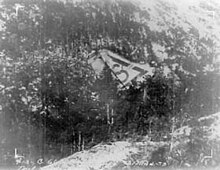 B-36s were involved in two "Broken Arrow" incidents. On 13 February 1950, B-36 serial number 44-92075, crashed in an unpopulated region of British Columbia, resulting in the first loss of an American atom bomb. The inert bomb's plutonium core had been replaced with lead, but it did have TNT, and it detonated over the ocean before the crew bailed out.[66] Locating the crash site took some effort.[67] On 4 November 2016, however, an object similar to the bomb was reported to have been located by a diver near the Haida Gwaii archipelago , 50 mi (80 km) off the coast of British Columbia. The Royal Canadian Navy deployed vessels to investigate.[68] After investigation, the Royal Canadian Navy determined that it was not the lost bomb.[69] Later in 1954, the airframe, stripped of sensitive material, was substantially destroyed in situ by a U.S. military recovery team. On 22 May 1957, a B-36 accidentally dropped a Mark 17 thermonuclear bomb 4.5 mi (7.2 km) away from the control tower while landing at Kirtland Air Force Base in Albuquerque, New Mexico. The weapon had come loose from its mounts and fell through the bomb bay doors, and sending the aircraft into an uncontrollable climb due to the sudden and unexpected weight shift. Only the conventional explosives detonated, as the bomb was unarmed. The aircraft made a safe landing. These incidents remained classified for decades. See list of military nuclear accidents.[61][70] Specifications (B-36J-III)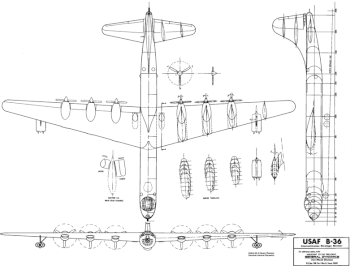 Data from National Museum of the U.S. Air Force[71] General characteristics
Performance
Armament
Notable appearances in mediaIn 1949, the B-36 was featured in the documentary film, Target: Peace, about the operations of the 7th Bombardment Wing at Carswell AFB. Other scenes included B-36 production at the Fort Worth plant. Strategic Air Command is a 1955 American film starring James Stewart as a Major League Baseball star and World War II veteran who is called back to active duty to become a B-36 pilot and flight commander for SAC. The documentary Lost Nuke (2004) chronicles a 2003 Canadian expedition to find the first lost nuclear weapon which traveled to the mountain site of the 1950 British Columbia B-36 crash.[73] See also
Related development Aircraft of comparable role, configuration, and era Related lists ReferencesNotes
Citations
Bibliography
External linksWikimedia Commons has media related to
|
||||||||||||||||||||||||||||||||||||||||||||||||||||||||||||||
